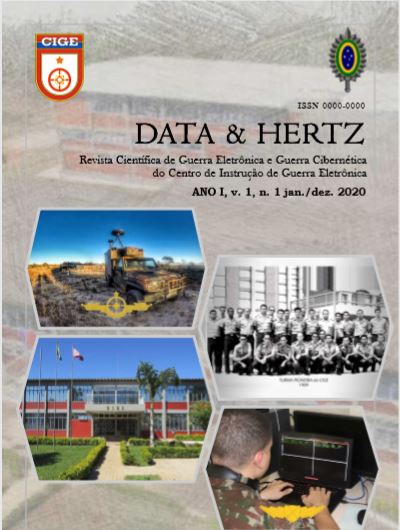Aplicação operacional da RF em fotônica
o enlace analógico a fibra óptica e a faixa dinâmica livre de espúrios
Resumo
Os primeiros sistemas a empregarem a tecnologia de radiofrequência (RF) em fotônica datam da década de 90. Desde então, diversas melhorias foram implementadas em sistemas de RF que utilizam dispositivos fotônicos, estejam estes dispositivos empregados em conjunto ou em substituição a dispositivos eletrônicos. Os dispositivos fotônicos têm sido empregados em Enlaces Analógicos a Fibra Óptica (EAFO) tendo em vista aplicações comerciais civis ou de interesse militar. Neste sentido, uma das características a estudar é a faixa dinâmica livre de espúrios (SFDR – Spurious Free Dynamic Range), que delimita, por exemplo, a sensibilidade e o ponto de operação, sem distorções de um radar ou de um sistema de
guerra eletrônica. Também são abordadas neste artigo algumas vantagens dos EAFO, já que eles asseguram maior eficiência aos sistemas de RF a eles associados, dado o emprego de dispositivos fotônicos. Prevê-se que os sistemas vocacionados para emprego militar que utilizem estes dispositivos estarão comercialmente disponíveis em um futuro bem próximo, compondo sistemas de armas e sistemas de guerra eletrônica, dadas as imposições dos cenários de combate e as perspectivas de evolução para as tecnologias de RF em Fotônica.
Downloads
Referências
CAPMANY, J.; NOVAK, D. Microwave photonics combines two worlds. Nature Photonics, Nature Publishing Group, v. 1, p. 319–330, June 2007.
COUTINHO, O. L. RF em Fotônica e suas aplicações em defesa. Brazil Cyber Defence Summit & Expo – Conferência de Simulação e Tecnologia Militar. Proceedings... 2018. Brasília – DF.
COX III, C. H. Analog Optical Links: theory and practice. Nova York: Cambridge University Press, 2004. 288 p.
COX III, C. H. et al. Limits on the performance of RF-over-fiber links and their impact on device design. IEEE Transactions on Microwave Theory and Techniques, v. 54, n. 2, p. 906– 920, Feb. 2006.
DIAS, P. E. S. Estudo do Ruído de Fase na Geração Fotônica de Sinais de RF: modelagem e caracterização. 2017. 194 f. Dissertação (Mestrado em Microondas e Optoeletrônica) – Instituto Tecnológico de Aeronáutica, São José dos Campos, 2017.
GHELFI, P. et al. A fully photonics-based coherent radar system. Research Letter. Nature, v. 507, p. 341–345, Mar. 2014.
KEISER, G. Comunicações por fibras ópticas. Porto Alegre: AMGH Editora Ltda, 2014. 659 p.
MAIMAN, T. H. Stimulated Optical Radiation in Ruby. Nature, v. 187, p. 494, Aug. 1960.
MELO, S. et al. Dual-use System Combining Simultaneous Active Radar & Communication, Based on a Single Photonics-Assisted Transceiver. In:INTERNATIONAL RADIO SYMPOSIUM – IRS, 17., 2016. Proceedings...
[S.l.], 2016.
OLIVEIRA, J. E. B.; ALVES, F. D. P.; MATTEI, A. L. P. Trends in photonics applied to electronic warfare at Brazilian Air Force. In: SBMO/IEEE MTT-S IMOC MICROWAVE OPTOELETRONIC CONFERENCE, 2., 1999, Rio de Janeiro. Proceedings... Psicataway: IEEE, 1999, p. 599–602.
RIDGWAY, R. W. et al. Microwave photonics programs at DARPA. Journal of Lightwave Technology, v. 32, n. 20, p. 3428-3439, Oct. 2014.
SANTOS, L. B. Análise de Sistemas de Comunicação Utilizando Óptica no Espaço Livre. 2008. 133 f. Dissertação (Mestrado em Engenharia Elétrica) – Instituto Militar de Engenharia, Rio de Janeiro. Disponível em:
SILVA, J. L. B. Filtros e linhas de retardo fotônicos integrados aplicados a sistemas de RF em Fotônica. 2017. 144 f. Dissertação (Mestrado em Ciências e Tecnologias Espaciais) – Instituto Tecnológico de Aeronáutica, São José dos Campos, 2017.
THAI Military and Asian Region - Zhuk-AE/FGA-35 modified radar with AESA (ROFAR). Disponível em:
MARQUES, R. B. et al. Perspectivas de modernização em guerra eletrônica: aplicação militar da fotônica. Spectrum, v. 1, n. 20, p. 32–38, set. 2017.



